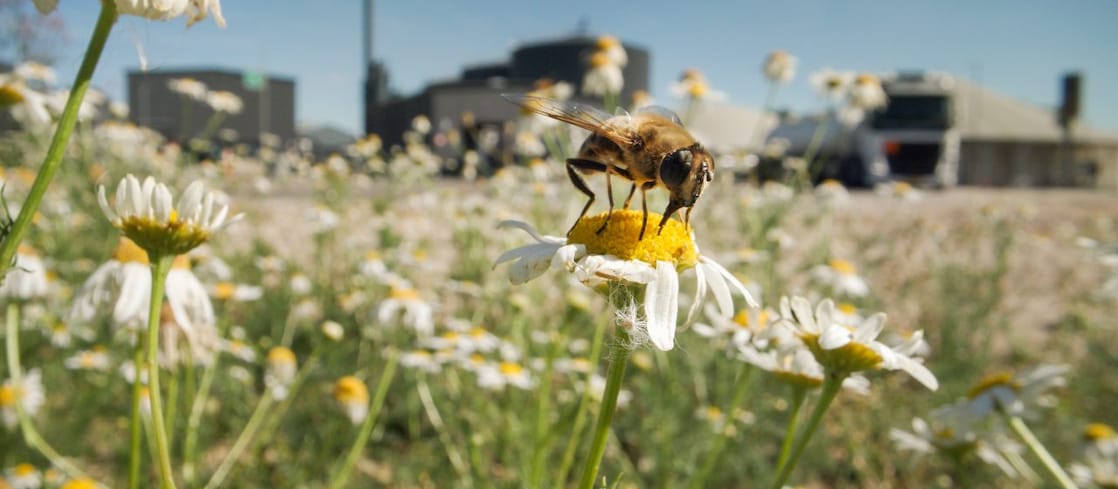
Biogas at Shell
Turning waste into value
Producing and supplying biogas is an important part of Shell’s strategy to become a net-zero emissions business by 2050. It is one of a range of low-carbon fuels that Shell produces to help customers worldwide reduce their carbon footprint.

What is biogas?
Biogas (also known as renewable natural gas) is made from animal manure and many other types of organic waste or residues. It consists mainly of 50–70% methane (CH4) and 30–45% carbon dioxide (CO2).
Biogas is versatile. It can be:
- Used as a fuel to reduce greenhouse gas emissions in hard-to-decarbonise sectors like commercial road transport, shipping, heavy industry and heating;
- Blended with conventional natural gas or used neat as a fuel without requiring costly investment in new grid or refuelling infrastructure, trucks or ships; and
- Produced in a sustainable circular process that converts the waste into biogas, reuses the CO2 extracted from the biogas, and returns the ‘digestate’ (the leftover solid and liquid material) to farmers as nutrient-rich fertiliser.
Source: Renewables 2024 – Analysis - IEA page 157Global demand for biogas is expected to grow by 30% between 2024 and 2030, according to the International Energy Agency. Key growth markets this decade include Europe, the USA, China and India.

Delivering biogas with impact
Today at Shell we own and operate 14 large-scale biogas plants in Europe following our acquisition of Denmark-based Nature Energy in 2023, one of the largest producers of biogas in Europe. Thirteen of these plants are in Denmark and the other co-owned facility is in France. We also have a substantial renewable natural gas business in North America and a large interest in a biogas plant in Brazil through our Raízen joint venture.
In 2024, we opened a bio-LNG (liquefied biomethane) production plant in Germany, producing enough fuel to help reduce carbon emissions from approximately 5,000 trucks each year. We also trade biogas globally, connecting production with customers around the world as part of our end-to-end energy operations.
We produce biogas according to the principles of the circular economy. We process biogas from organic waste, harness the biomethane and – at selected plants - the carbon dioxide and turn them into low-carbon fuels and fertiliser.
By analysing the bacterial composition of various waste types, we can extract more biomethane and carbon dioxide, converting them into larger volumes of valuable products.
We’ve built strong, long-term relationships across the biogas supply chain including with large-scale farmers, farming co-operatives, food and beverage companies and municipalities that provide the organic waste; utilities, and transport and shipping companies that use the low-carbon fuels; and companies we trade with internationally.
Unlocking the potential of organic waste
Anaerobic digestion produces two main outputs: digestate which is the leftover solid and liquid material, and biogas which is a mixture of biomethane and carbon dioxide.
Once anaerobic digestion is complete, we separate these two gases – also known as upgrading - so that the biomethane can be injected directly into the gas grid for use in homes, businesses and industry. Or it can be liquefied or compressed into fuel like bio-LNG to help heavy-duty trucks and ships reduce their greenhouse gas emissions.
The carbon dioxide can be stored underground in carbon capture, utilisation and storage facilities. It can be cleaned and used in multiple applications, such as carbonated drinks and to increase yields of fruit and vegetables grown in greenhouses. And it can be used to produce hydrogen which, when mixed with additional carbon dioxide, creates even more renewable methane – all from the same original volume of waste.
Finally, we return the nutrient-rich digestate to farmers as a solid or liquid fertiliser. Where needed, the nutrient ratios can be tailored to meet specific agricultural requirements.

Large-scale production makes the difference
Shell applies a large-scale circular model that transforms animal manure and other organic waste—from agriculture, industry, and households—into low-carbon fuels and fertiliser.
We make the biogas through anaerobic digestion, a process in which naturally occurring microorganisms break down – or digest – the waste and then convert it into biogas, carbon dioxide and digestate. The process occurs in a sealed, oxygen-free environment called an anaerobic digester.
Large-scale production allows us to process a wider variety of locally available organic feedstocks. This includes sourcing from large dairy farms in the U.S. and farming cooperatives in Europe.




